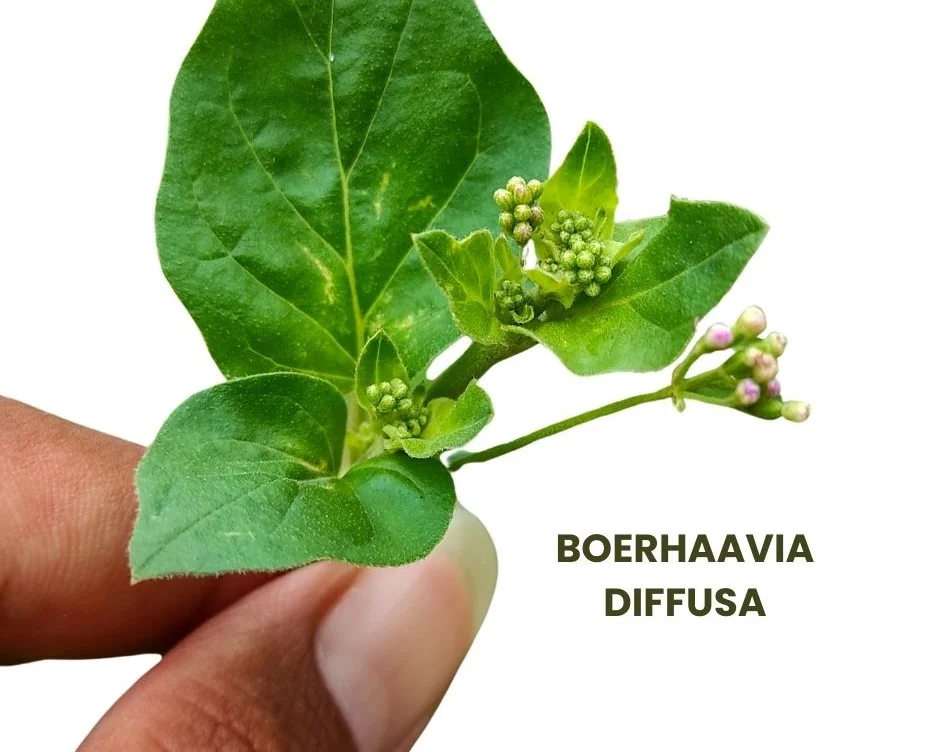Boerhaavia diffusa, commonly known as Punarnava, is a medicinal plant with a rich history of use in traditional medicine systems.
It is valued for its therapeutic properties in treating various ailments, including asthma, high blood pressure, dropsy, jaundice, and heart troubles.
First Prover: S.C. Ghosh.

Table of Contents
ToggleSOURCE INFORMATION
Scientific Classification
- Kingdom: Plantae
- Family: Nyctaginaceae
- Genus: Boerhaavia
- Species: Boerhaavia diffusa
Origin and Historical Facts
- Native Habitat: Boerhaavia diffusa, commonly known as Punarnava, is native to the Indian subcontinent and other tropical regions.
- Traditional Medicine: The plant has a long history of use in Ayurveda, the traditional Indian system of medicine, where it is highly esteemed for its medicinal properties.
- Usage in Ayurveda: In Ayurvedic medicine, Punarnava is classified as a Rasayana herb, meaning it is believed to promote longevity and rejuvenation.
- It is used to treat a wide range of ailments, including urinary disorders, liver conditions, edema, inflammation, and various other health issues.
Cultural Significance
Punarnava holds cultural significance in India, where it has been traditionally used in herbal formulations and remedies for centuries.
It is also known as “Punarnava” in Sanskrit, which translates to “Renewer” or “One that rejuvenates.”
Historical Context
- The plant is named after Hermann Boerhaave, an eminent Dutch botanist, and physician of the 17th and 18th centuries.
- Boerhaave made significant contributions to the field of medicine and botany during his lifetime, and several plants were named in his honor.
READ THE HISTORY OF MEDICINE BY FOLLOWING THE LINK.
Usage in Modern Medicine
- Today, Boerhaavia diffusa continues to be used in traditional medicine systems, as well as in modern herbalism and Ayurvedic practice.
- It is valued for its diuretic, anti-inflammatory, hepatoprotective, and antioxidant properties, and research continues to explore its potential therapeutic benefits for various health conditions.
Cultivation and Distribution
- Boerhaavia diffusa is cultivated in tropical and subtropical regions worldwide for its medicinal properties.
- It is often grown in home gardens, herbal farms, and botanical gardens, where it is harvested for medicinal use.
- Additionally, wild populations of Punarnava can be found in natural habitats across its native range, where it grows as a weed or underbrush in moist, sandy soils near water bodies.
Commercial Availability
- Punarnava products, including powders, capsules, extracts, and tinctures, are commercially available in herbal stores, Ayurvedic pharmacies, and online platforms catering to natural health products.
- These products are often used as dietary supplements or as components of herbal formulations for various health purposes.
Regulatory Status
- In some countries, Boerhaavia diffusa products may be regulated as dietary supplements or herbal remedies, subject to specific regulations governing their production, labeling, and sale.
- It is essential to consult local authorities and healthcare professionals for guidance on the safe and legal use of Punarnava products.
DRUG PATHOGENESIS
- Boerhaavia diffusa exerts its medicinal effects primarily on the respiratory, circulatory, hepatic, and urinary systems.
- It helps alleviate symptoms associated with asthma, high blood pressure, dropsy, jaundice, and rheumatic pains.
KEY CHARACTERISTICS
- Head: Individuals experience a severe, bursting headache on the right side, which is alleviated by applying cold; often accompanied by dizziness.
- Cough: Coryza is accompanied by a dry cough, with thick white expectoration.
- Heart: Frequent palpitations are observed along with intermittent throbbing pain in the cardiac region.
- Liver: Slight pain is felt in the hepatic region, which is relieved by applying hard pressure; this symptom is indicative of potential cirrhosis of the liver.
- Swelling: Swelling occurs in various parts of the body, including the eyelids, hands, abdomen, legs, and feet.
- Urinary Organs: Urine is scanty and high-colored, often accompanied by strangury, a painful and difficult urination.
- Pain: Rheumatic pains affect the entire body, causing discomfort and stiffness.
MODALITIES
- Symptoms better by hard pressure, especially in the hepatic region.
RELATIONSHIP WITH OTHER DRUGS
- Boerhaavia diffusa may complement other remedies indicated for similar conditions, such as those used for respiratory ailments, hypertension, and hepatic disorders.
DOSE
- The mother tincture is the potency of choice for Boerhaavia diffusa.
Frequently Asked Questions
What conditions is Boerhaavia diffusa used for?
- Boerhaavia diffusa is used for asthma, high blood pressure, dropsy, jaundice, heart troubles, and rheumatic pains.
What is the potency of choice for Boerhaavia diffusa?
- The mother tincture is commonly used for this remedy.
What are the key characteristics of Boerhaavia diffusa?
- Key characteristics include headache, cough with expectoration, palpitations, hepatic pain, swelling, urinary symptoms, and rheumatic pains.
Meaning of Difficult Words
- Dropsy: Swelling caused by fluid retention in the body’s tissues.
- Jaundice: A medical condition characterized by yellowing of the skin and whites of the eyes due to elevated levels of bilirubin in the blood.
- Cirrhosis: A chronic liver disease characterized by scarring and damage to the liver tissue, often leading to liver dysfunction.
- Strangury: Painful and frequent urination with difficulty passing urine.
